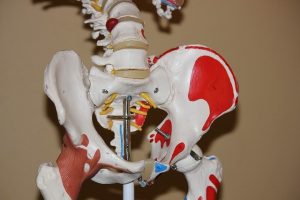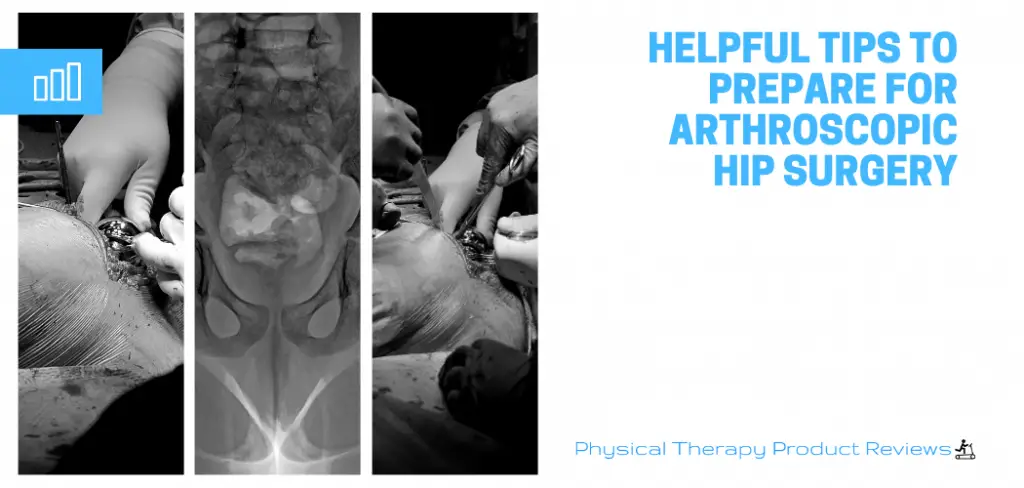Despite what you may have heard, preparing for a hip arthroscopic surgery can be a seamless process. The key to ensuring a smooth recovery lies in informed and thoughtful preparation.
 Hip arthroscopy is a minimally invasive surgery of the hip meant to address a range of joint issues, like impingement and labral tears. The recovery time is usually on the shorter side and many patients can expect to make a full recovery.
Hip arthroscopy is a minimally invasive surgery of the hip meant to address a range of joint issues, like impingement and labral tears. The recovery time is usually on the shorter side and many patients can expect to make a full recovery.
Even though your surgeon will be doing the “fixing”, it will be up to you to make sure your recovery goes well. Follow these helpful tips to best prepare for your surgery and make the most out of your rehabilitation after!
Hip Arthroscopy - Know what to Expect
Discuss expectations with your surgeon and read through any procedure handouts the clinic provides. Learning about the process of hip arthroscopy can help you understand how to prepare for it.
Recovery After Hip Scope:
Good news! Your symptoms should start improving right away! However, that doesn’t mean you’ll be ready to run a marathon on Day 2. Don’t plan for any activities outside the home for the first few weeks after surgery.
You’ll likely be using crutches for these initial weeks and be scheduled to attend Physical Therapy for 4-6 weeks, depending on the depth of your procedure. Full recovery is expected and can take somewhere between 3-6 months. Your physical therapist can give you a more exact expectation based on your specific repairs, activity level, and lifestyle.
In the weeks and months following surgery, you’ll have a good number of appointments for physical therapy and check-ins with your surgeon. Keep track of it all on a big calendar in your home, or a shared digital calendar, so your caretaker is on the same page that you are.
Hip Pain After Hip Surgery:
No surgery is without some pain and discomfort. So, aside from your pain medications, you might want to have some ice packs stashed in the freezer too.
Talk to your doctor about including a turmeric supplement in your daily habit. Turmeric is an herbal extract that has been shown to improve postoperative pain and fatigue and help alleviate symptoms of arthritis.
For more nutrition tips, see the section “Prepare your home for recovery” below on how to include an anti-inflammatory diet in your preparation.
Meet with a Physical Therapist
Your physical therapist will be your recovery guide! Plan to have both a pre-operative and post-operative consultation to keep you on track.
Pre-Operative Visit:
 Your provider can discuss exercises for you to do before surgery to help improve your range of motion and maintain your strength. They will also discuss precautions to keep in mind, how to walk with crutches, and how to care for your wound.
Your provider can discuss exercises for you to do before surgery to help improve your range of motion and maintain your strength. They will also discuss precautions to keep in mind, how to walk with crutches, and how to care for your wound.
They will even give you exercises to do to help you have a better and faster outcome. The stronger and more motion that you have going into surgery the easier it is to recover after surgery.
Post-Operative Visit:
As early as Day 1 post-surgery, you’ll see your physical therapist and begin your rehabilitation. Your PT will guide you through how to move properly, how to activate muscles that might be weak after surgery, and assign you exercises to complete at home.
From there, you can expect to attend physical therapy regularly to progress through your rehab program. A typical session will include a check-in with your provider to inspect your wound, a gentle warm-up, progressive exercises, and a cool-down with an ice pack or compression sleeve. Your physical therapist will follow specific guidelines for your activity graduation as they lead you through your rehabilitation.
The first 2 weeks of therapy after hip scope are critical to establishing a normal healing routine. It’s key to begin doing exercises early and often that fits within your surgical precautions.
Prepare your Home for After Hip Surgery
In the days leading up to your procedure, spend some time preparing your home for your return. This step makes a world of difference in how you’ll be able to relax and keep things frustration-free when you get out of surgery.
Home:
Keep in mind that you will be using crutches for at least a week. Make sure your floors are free from clutter so any paths you need to travel (think bedroom to the bathroom) will be without obstacles.
Try to avoid stairs, but if it’s impossible, your physical therapist can instruct you on how to safely navigate stairs with crutches in your pre-operative appointment.
Caregiver:
 Ideally, you have a helper at home, especially in the first few weeks after surgery. It’s best if that person can attend pre-operative appointments with you so they understand how to best assist you after your surgery. Having a caregiver to help you move around, prepare food, and do light chores like laundry can be of great help while you focus on rest and recovery. Be sure to thank them well!
Ideally, you have a helper at home, especially in the first few weeks after surgery. It’s best if that person can attend pre-operative appointments with you so they understand how to best assist you after your surgery. Having a caregiver to help you move around, prepare food, and do light chores like laundry can be of great help while you focus on rest and recovery. Be sure to thank them well!
Nutrition:

Do some meal-planning to chart out health-promoting foods to include in your diet after (and before!) you come back from surgery. Yes, food can actually help you heal! Cut out the junk that can aggravate inflammation and include foods that are high in antioxidants to improve your recovery and overall health. This article from Harvard Health has some great tips!
Staying hydrated before and after your surgery will be important as proper hydration is key to adequate wound healing. Have a big water bottle by your side to remind you to drink water throughout the day.
Attire:
Shoes: It’s going to be a bit difficult to bend down to reach your feet following surgery, so have some slip-on shoes to wear around the house and outside of your home ready to go.
Clothing: You’ll be most comfortable in loose-fitting bottoms that are easy to pull on. Go through your wardrobe and place appropriate clothes in a high and easy to reach drawer – remember, it’s going to be difficult to bend over for a while!
Getting around: Having a small backpack to carry can be a great relief when you’re trying to tote items while walking with crutches. You can easily carry your essentials (like that big water bottle!) and post-op paperwork on your back without having to worry about a handbag getting in the way.
Plan for a Successful Surgery and Recovery
With these tips, you’ll be very prepared for your hip arthroscopy. Remember to follow the advice of your physical therapist as you approach surgery and in your rehabilitation time after for the best recovery!
Works Referenced
Agarwal KA, Tripathi CD, Arawak BB, Saluja S. Efficacy of turmeric (cur cumin) in pain and postoperative fatigue after a laparoscopic cholecystectomy: a double-blind randomized placebo-controlled study. Surgical Endoscopy. 2011; 25: 3805-3810. https://link.springer.com/article/10.1007/s00464-011-1793-z
Daily JW, Yang M, Park S. Efficacy of turmeric extracts and Curcumin for alleviating the symptoms of joint arthritis: a systematic review and meta-analysis of randomized clinical trials. Journal of Medicinal Food. 2016: 19(8). https://www.liebertpub.com/doi/full/10.1089/jmf.2016.3705
Domb BG, Sgroi TA, VanDevender JC. Physical therapy protocol after hip arthroscopy. Sports Health. 2016; 8(4): 347-354. https://www.ncbi.nlm.nih.gov/pmc/articles/PMC4922519/
Foods that fight inflammation. Harvard Health Publishing; Harvard Medical School. 2020. https://www.health.harvard.edu/staying-healthy/foods-that-fight-inflammation
Rehabilitation Guidelines for Hip Arthroscopy Procedures. UW Health Sports Rehabilitation. https://www.uwhealth.org/files/uwhealth/docs/pdf2/Rehab_Hip_Arthroscopy.pdf
Other Great Rehab Related Articles
Dealing with Painful Stairs After Ankle Replacement Surgery
Walking After a Total Ankle Replacement: Tips for a Successful Recovery
Exercises While Non-Weight Bearing After Ankle Replacement: Elevation, AROM, Leg Raises, and More
Ankle Pain with Stairs: Causes and Home Treatment Options
5 Common Mistakes You’re Making After an Ankle Sprain
6 Great Ways to Reduce Low Back Pain with Driving
Disclaimer: The information provided in this post is for educational purposes only. This is not a substitute for a medical appointment. Please refer to your physician before starting any exercise program.








last year, my dad had an accident where he hurt his hip and knee. He had to have surgery on his knee and his doctor told us that he’ll eventually need surgery on his hip as well. Currently, I am trying to verse myself on different types of hip surgeries, in case I need to be there to help. Do you have any more tips for caregivers of those who’ve had hip replacements?